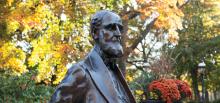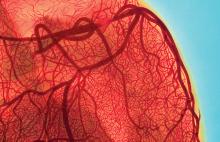
Amyotrophic lateral sclerosis (ALS), more commonly known as Lou Gehrig’s disease, is a devastating, fatal neurological disease for which there currently is no cure. Developing a better model to understand these types of diseases is the focus of Nathan Wittenberg.
Wittenberg, assistant professor of chemistry, studies the biological surfaces, specifically the lipid membrane, that construct the boundaries of cells. Cell boundaries are made up of complex environments that include proteins, sugars and lipids. Wittenberg simplifies these environments by creating models of the cell membrane, then builds in complexity one step at a time. His work focuses on integrating membranes into biosensors. With many medications, the drug interacts with a specific receptor on the surface of a cell. Using two separate membrane systems—one flat, the other a sphere, or a vesicle—Wittenberg’s lab examines these interactions using fluorescent microscopy. He then examines the molecular interaction with these surfaces, providing measurable data to answer questions surrounding issues such as how long the interactions persist, how strong the interactions are and how quickly they form or fall apart.
“By doing this, we’re able to interrogate how these membranes interact, almost to the level of single molecule interactions,” says Wittenberg. “When you look at individual events like this, you can get a lot more information than more traditional analyses. When you start looking at individual events, then you can start to tease apart unique properties of the individuals. Not every binding event is the same. By examining groups of individual events, we can get more information about different types of interactions on biological surfaces.”
His work is helping to provide a more assessable picture of how the antibodies interact with models of cell membrane surfaces. Wittenberg collaborates with researchers in the neurology department at the Mayo Clinic to explore therapeutic strategies for ALS. The team discovered a group of antibody molecules that, Wittenberg says, have some interesting properties in promoting nervous system repair. Some of the antibodies stick to specific types of cells in the nervous system, and Wittenberg and his team are helping the Mayo Clinic better understand how these surface interactions lead to the function of the molecule. Mayo scientists applied Wittenberg’s work when studying two sets of mice that have genetic mutations causing ALS. The researchers found that if mice were given a single dose of this antibody, the animals lived longer. The animals also possessed more living motor neurons in the spine than prior to the antibody treatment. He is also shedding light on how these interactions disrupt certain normal interactions found on cell surfaces.
“In the diseased nervous system, especially for diseases like multiple sclerosis or ALS—where there’s a lot of cell death and we want to promote some repair—it’s very difficult because there’s a lot of these inhibitory interactions.”
Wittenberg will test whether these antibodies disrupt inhibitory interactions in the nervous system. By doing so, they envision possible strategies to stimulate cell repair. The team’s work might prove significant to discovering future treatment strategies.
































